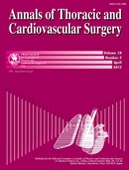Volume 17, Issue 2
Displaying 1-26 of 26 articles from this issue
- |<
- <
- 1
- >
- >|
Obituary
-
2011Volume 17Issue 2 Pages 99
Published: 2011
Released on J-STAGE: June 16, 2011
Download PDF (166K)
Editorial
-
2011Volume 17Issue 2 Pages 100-102
Published: April 25, 2011
Released on J-STAGE: June 16, 2011
Download PDF (70K)
Review
-
2011Volume 17Issue 2 Pages 103-109
Published: April 25, 2011
Released on J-STAGE: June 16, 2011
Download PDF (1637K)
Original Articles
-
2011Volume 17Issue 2 Pages 110-117
Published: April 25, 2011
Released on J-STAGE: June 16, 2011
Download PDF (328K) -
2011Volume 17Issue 2 Pages 118-123
Published: April 25, 2011
Released on J-STAGE: June 16, 2011
Download PDF (1142K) -
2011Volume 17Issue 2 Pages 124-129
Published: April 25, 2011
Released on J-STAGE: June 16, 2011
Download PDF (247K) -
2011Volume 17Issue 2 Pages 130-136
Published: April 25, 2011
Released on J-STAGE: June 16, 2011
Download PDF (113K) -
2011Volume 17Issue 2 Pages 137-142
Published: April 25, 2011
Released on J-STAGE: June 16, 2011
Download PDF (204K) -
2011Volume 17Issue 2 Pages 143-147
Published: April 25, 2011
Released on J-STAGE: June 16, 2011
Download PDF (91K) -
2011Volume 17Issue 2 Pages 148-152
Published: April 25, 2011
Released on J-STAGE: June 16, 2011
Download PDF (338K) -
2011Volume 17Issue 2 Pages 153-159
Published: April 25, 2011
Released on J-STAGE: June 16, 2011
Download PDF (421K) -
2011Volume 17Issue 2 Pages 160-165
Published: April 25, 2011
Released on J-STAGE: June 16, 2011
Download PDF (660K)
Case Reports
-
2011Volume 17Issue 2 Pages 166-169
Published: April 25, 2011
Released on J-STAGE: June 16, 2011
Download PDF (2512K) -
2011Volume 17Issue 2 Pages 170-173
Published: April 25, 2011
Released on J-STAGE: June 16, 2011
Download PDF (1565K) -
2011Volume 17Issue 2 Pages 174-177
Published: April 25, 2011
Released on J-STAGE: June 16, 2011
Download PDF (4601K) -
2011Volume 17Issue 2 Pages 178-181
Published: April 25, 2011
Released on J-STAGE: June 16, 2011
Download PDF (954K) -
2011Volume 17Issue 2 Pages 182-184
Published: April 25, 2011
Released on J-STAGE: June 16, 2011
Download PDF (1242K) -
2011Volume 17Issue 2 Pages 185-189
Published: April 25, 2011
Released on J-STAGE: June 16, 2011
Download PDF (833K) -
2011Volume 17Issue 2 Pages 190-193
Published: April 25, 2011
Released on J-STAGE: June 16, 2011
Download PDF (1419K) -
2011Volume 17Issue 2 Pages 194-197
Published: April 25, 2011
Released on J-STAGE: June 16, 2011
Download PDF (1158K) -
2011Volume 17Issue 2 Pages 198-200
Published: April 25, 2011
Released on J-STAGE: June 16, 2011
Download PDF (731K) -
2011Volume 17Issue 2 Pages 201-203
Published: April 25, 2011
Released on J-STAGE: June 16, 2011
Download PDF (329K) -
2011Volume 17Issue 2 Pages 204-207
Published: April 25, 2011
Released on J-STAGE: June 16, 2011
Download PDF (587K) -
2011Volume 17Issue 2 Pages 208-211
Published: April 25, 2011
Released on J-STAGE: June 16, 2011
Download PDF (420K) -
2011Volume 17Issue 2 Pages 212-214
Published: April 25, 2011
Released on J-STAGE: June 16, 2011
Download PDF (601K)
Erratum
-
2011Volume 17Issue 2 Pages 215
Published: 2011
Released on J-STAGE: June 16, 2011
Download PDF (30K)
- |<
- <
- 1
- >
- >|
